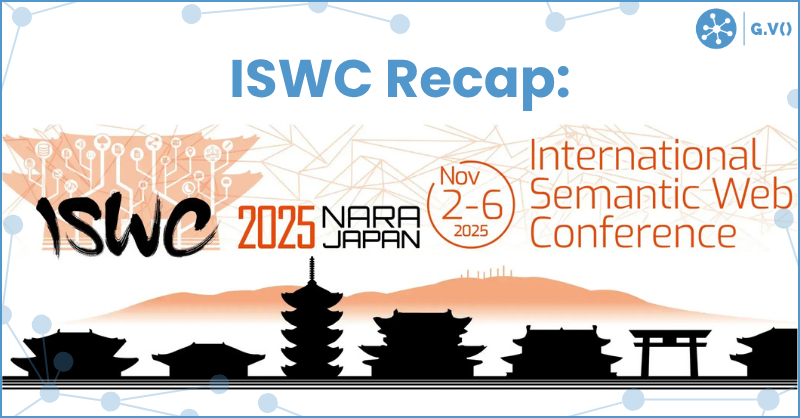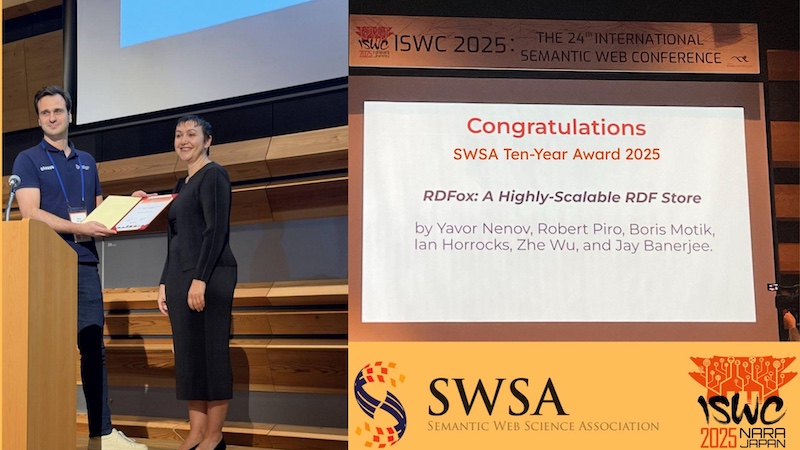ISWC Recap: Trends & Reflections from the International Semantic Web Conference 2025

If you weren’t in Nara, Japan earlier this month, then you certainly missed out – not only on your chance to feed a wild sika deer but also on the main Semantic Web event of the year: the International Semantic Web Conference (ISWC) 2025.
Recent years’ editions of ISWC have been a clear reflection of a maturing ecosystem. The community seems to have moved decisively past the phase of demonstrating that RDF and SPARQL work. Now it’s about how far and how fast semantic technologies can go when integrated into large-scale industrial and AI-driven environments.
In this recap blog post, I take a broad look at ISWC 2025 and summarize the main events, awards, and trends coming out of this year’s International Semantic Web Conference.
Awards & Recognitions
The awards at ISWC reflected the community’s growing focus on practical scalability, hybrid reasoning, and interpretability.
The Best Resource Paper, “MammoTab 25: A Large-Scale Dataset for Semantic Table Interpretation – Training, Testing, and Detecting Weaknesses,” captured one of the core bottlenecks in knowledge graph construction: the lack of realistic, large-scale benchmarks for evaluating LLMs on tabular data.
The winning approach from the SemTab Challenge – “ADFr: Knowledge Graph Entity Linking via Interactive Reasoning and Exploration with GRASP” – reinforced this trend by showcasing progress in entity linking.
The Best Research Paper, “FLORA: Unsupervised Knowledge Graph Alignment by Fuzzy Logic,” brought the conversation back to semantics itself, proposing fuzzy logic-based alignment without supervision, a reminder that precision and interpretability still define the heart of the Semantic Web.
Of note, the SWSA Ten-Year Award was awarded to RDFox, which could hardly be more symbolic. See them receiving the award in the image below.
Ten years ago, RDFox – which incidentally is on our target list for G.V() support – pushed the boundaries of what an RDF triplestore could achieve in terms of in-memory reasoning and incremental materialisation.
Today, the fact that RDFox is being celebrated means the community has accepted that reasoning engines aren’t optional; they’re core infrastructure. High-throughput, parallel reasoning, and billions of triples in live systems are no longer research bragging rights but real operational expectations.
Other Trends & Reflections from ISWC
Another striking current running through ISWC 2025 was the deep fusion between knowledge graphs and large language models (LLMs).
The workshops, particularly the Wikidata Workshop, made it clear that the once-separate worlds of symbolic and statistical AI are colliding productively. There was substantial interest in LLM-enhanced SPARQL generation, automated fact-checking with hybrid pipelines, and self-updating knowledge graphs powered by generative systems.
As I said, the Semantic Web community is no longer defending RDF as a self-contained stack but actively exploring how it can serve as the structured substrate beneath modern AI systems.
The Industry and In-Use tracks were filled with cases of semantic technologies deployed in supply-chain monitoring, robotics data ecosystems, public-sector registries, and even mobile edge analytics. These weren’t just proof-of-concepts; they were running systems.
This industrialisation of the Semantic Web is arguably the most important development: the ideas that once lived in academic prototypes are now being engineered into data fabrics, decision-support systems, and compliance pipelines.
Conclusion
Taken together, ISWC 2025 confirmed three converging trajectories: scalability, intelligence, and operationalisation. RDF triplestores and reasoning engines must now scale like databases. Knowledge graphs must learn and interact like AI systems. And all of it must run reliably in production.
For practitioners building or supporting semantic pipelines – especially those concerned with validation, reasoning, or integration at scale – these trends mark a decisive new chapter. The Semantic Web is no longer a research ideal; it will be the main infrastructure for generative AI over the next decade.
Level up your RDF game: Experience how G.V() helps you get more graph tasks done – from SPARQL query editing to interactive graph visualization and more – all in one IDE.

![The Weekly Edge: RDF Edition! [14 November 2025] The Weekly Edge: RDF Edition! [14 November 2025]](https://gdotv.com/wp-content/uploads/2025/11/rdf-triplestore-sparql-weekly-edge-14-november-2025.png)
![RDF Support Is Now Available in G.V() [v3.41.99 Release Notes] RDF Support Is Now Available in G.V() [v3.41.99 Release Notes]](https://gdotv.com/wp-content/uploads/2025/11/rdf-triplestore-sparql-support-gdotv-graph-database-IDE.png)
![The Weekly Edge: Kuzu Forks, DuckDB Goes Graph, Cypher 25 & More [24 October 2025] The Weekly Edge: Kuzu Forks, DuckDB Goes Graph, Cypher 25 & More [24 October 2025]](https://gdotv.com/wp-content/uploads/2025/10/ladybug-graph-database-duckdb-cypher-weekly-edge-24-october-2025.png)